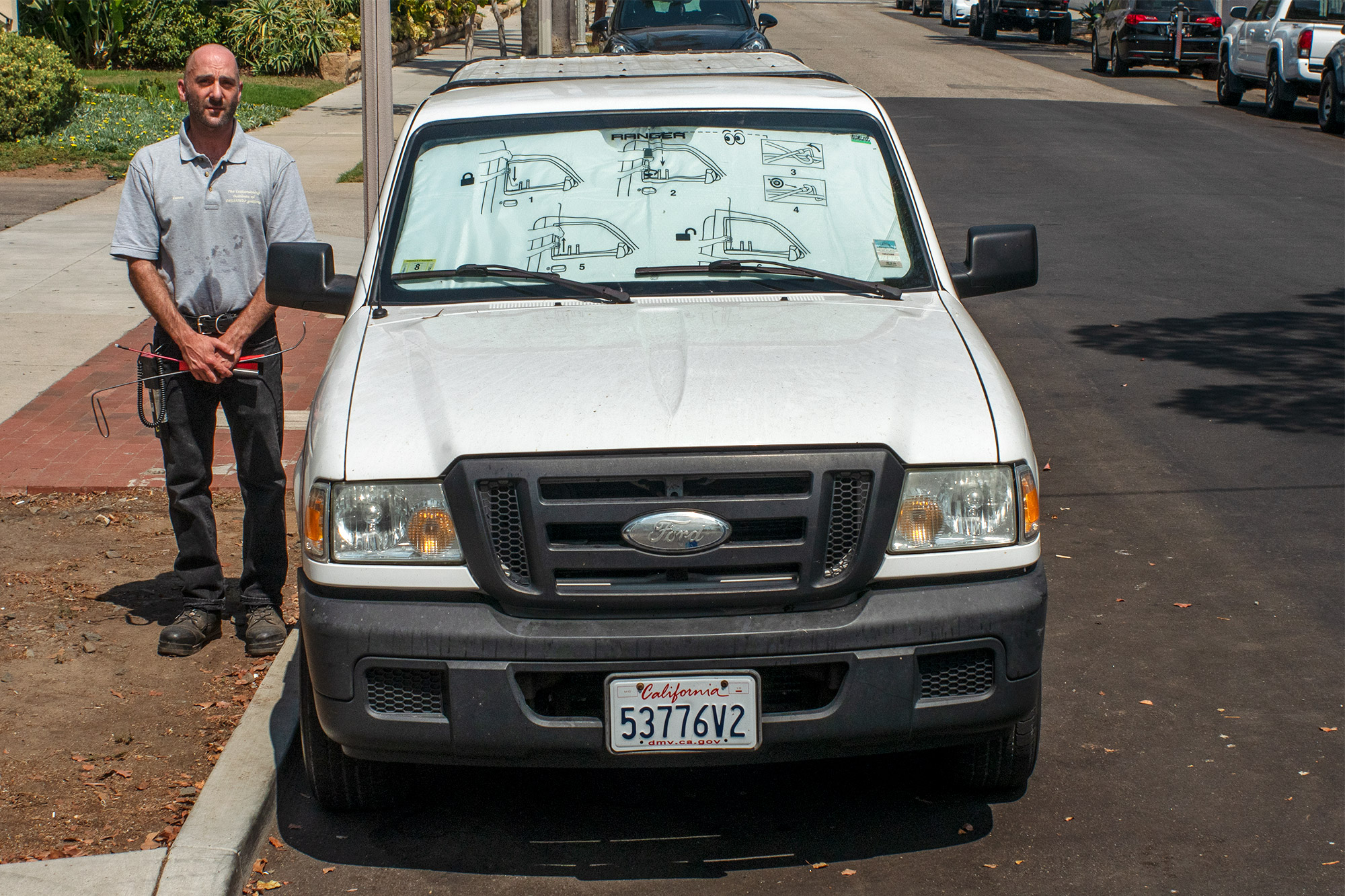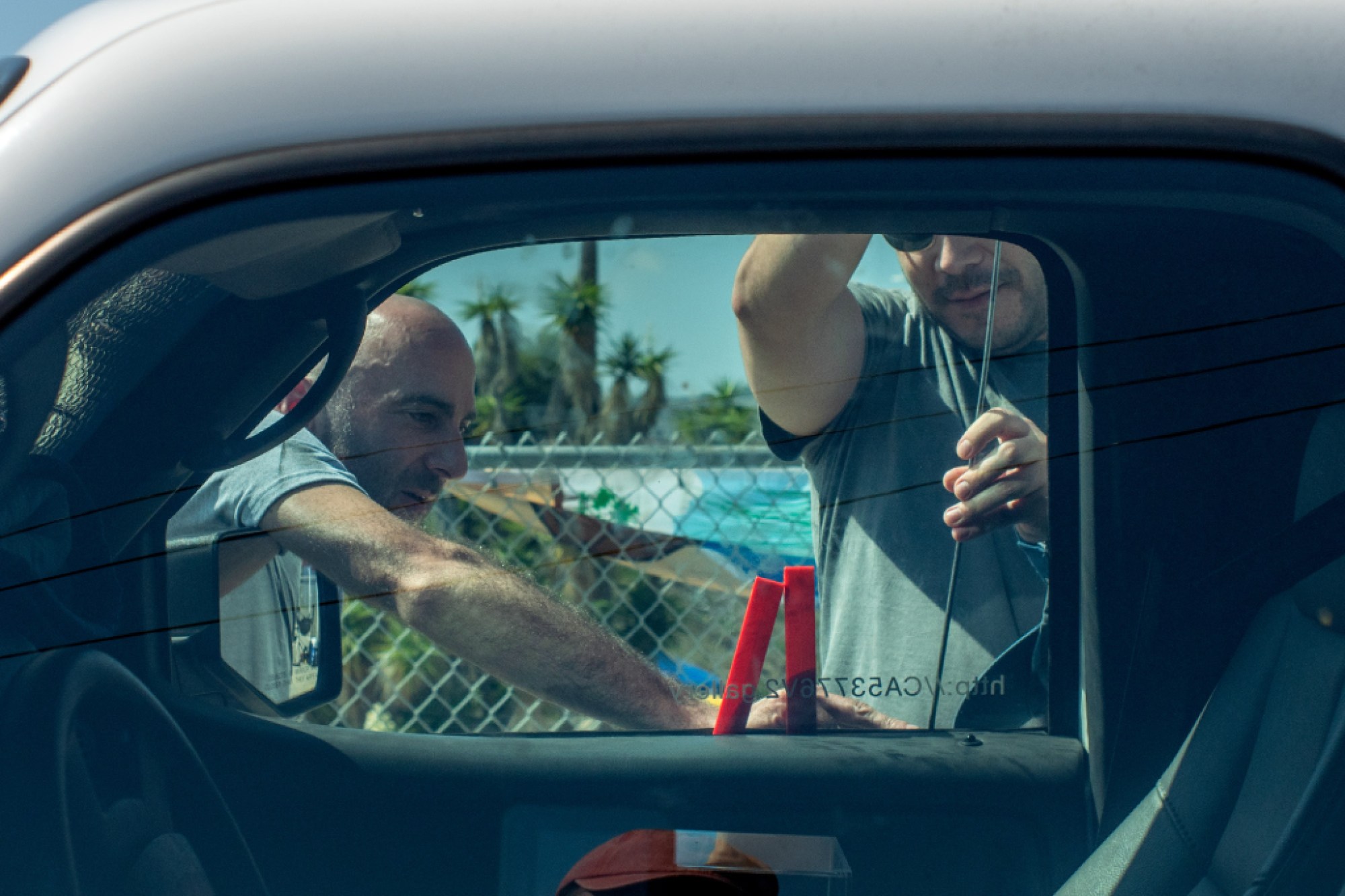The Art of Breaking into Cars
Cracking Open Santa Barbara’s Mobile Art Gallery with Artist Lucas Murgida of the Locksmithing Institute

Yesterday I learned how to break into a car — but I swear it was for the sake of art.
It was all part of one of the most unique art installations on display in Santa Barbara, the CA53776V2.gallery — an art gallery and exhibition space located on the dashboard of a white 2007 Ford Ranger parked along the 300 block of West Anapamu, created by artist and assistant professor of print and publication at UC Santa Barbara Alex Lukas.
Lukas started the experimental gallery during the pandemic, when he was exploring ideas for alternative art spaces that could still be viewed while traditional galleries remain closed. He owned the aging Ranger for years, and decided to try and use the truck’s cab and dashboard as a pop-up art space, parked on a sleepy side street a few blocks away from downtown. The car gallery featured works of artists of all backgrounds in a place anybody could visit, pushing the boundaries of who can make and view art.
Since opening, the truck-turned-gallery has featured the works of dozens of artists, with four main exhibitions on Anapamu Street during spring 2021, fall 2021, spring 2022, and fall/winter 2022-2023. It has also made the trip to a few “off-block” exhibitions, including the Other Places Art Fair in San Pedro and the Fulcrum Press Winter Trading Post in Los Angeles.

On Sunday, CA537782V2.gallery (yes, the name comes from the car’s California license plate number) invited guests to participate in an installation that pushed the boundaries of accessibility in art even further, with a lesson on how to break into the car art gallery with Los Angeles–based artist and locksmithing expert Lucas Murgida.
Murgida — whose background includes careers as a professional cabinetmaker, busboy, locksmith, yoga-teacher, and working on adult-fetish films — uses his collected knowledge to create art experiences that blur the line between public and private moments. In February 2005, he started the Locksmithing Institute, traveling all over the country — and once to Uruguay and Mexico — to teach lessons in lockpicking while also analyzing ideas such as “safety and security,” or “confinement and freedom.”
Sunday’s exhibition in Santa Barbara marked Lesson #15: where visitors could “get into the institution,” Murgida said, using easily available tools, then leave a little piece of themselves behind.
It starts, funnily enough, with a piece of chewing gum. Murgida asks me to take a piece of gum from an assortment of packs in a small box sitting on the curb beside the truck, then tells me to chew while he explains the process, using a six-step process conveniently illustrated on the sunshade stretched across the windshield.
While there are a lot of ways to open up a car, he says, the “classic method” is using a strip of metal called a “slim-jim” to manipulate the lock mechanism. In his time as a locksmith, Murgida would carry up to 50 different slim-jims in his work truck, each made specifically for a certain vehicle make or model. But today, he hands me a length of metal, about 15 inches long and bent at each end at two different angles. This modified homemade slim-jim can be made out of just about any type of metal as long as it is stiff enough — a coat hanger, he says, is too thin and would bend too easily.
After wedging the door window open with two separators, which create enough space between the glass and the rubber weather stripping, Murgida shows me how to look inside the small space to locate the “button,” a piece of metal linkage that connects to the lock body lower down on the door.
Maneuvering the slim-jim in and out of the small gap is the most challenging part, but once the metal is in, and the piece is far enough to reach the lock box, it’s surprisingly easy to jimmy the lock open. After about 10 seconds swinging the metal around, the small black button on the inside of the car pops up, and just like that, the door handle opens like a charm.
Once inside, Murgida invites me to take my piece of gum, now properly mangled and chewed, and place it in a small clear case in the center console on the front seat, on top of a sculpture made of about 20 or 30 other chewed pieces.
As a souvenir, Murgida hands me a brochure of the instructions illustrated on the sunshade and a printed lesson plan, which explains the thinking behind showing people these skills as a form of art. These lessons, the plan reads, are attempts to show people the “backdoor” ways to gain access to social wealth that is at times kept “physically and symbolically away by people in positions of expertise and authority.”

By breaking into Santa Barbara’s CA53776V2.gallery, Murgida writes, students will learn “that they too have the power to open up the institutionalized power within” and “become their own authority, gatekeeper, and curator.”
It was one of the most unique art experiences I’ve been able to take part in, and sort of bittersweet, as the truck gallery’s owner tells me that the Ranger is on its last legs — rusted through from hundreds of thousands of miles on the road — and this may well be the gallery’s final exhibition. Until then, it will remain “open” every day, parked along the 300 block of West Anapamu Street, just up the block from the Westside Neighborhood Center.




You must be logged in to post a comment.